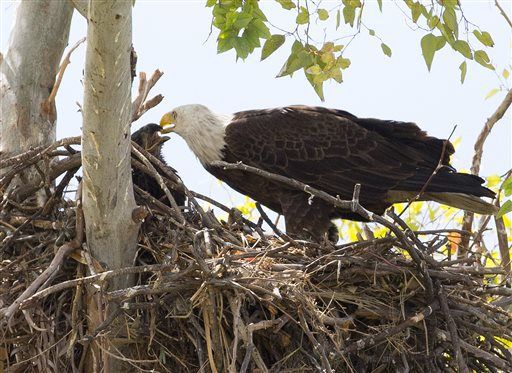A federal appeals court rebuffed a bid to have the Sonoran Desert area bald eagle listed as endangered, saying, in essence, that if they all are eradicated it wouldn’t make a real difference to eagle populations as a whole.
The 9th U.S. Circuit Court of Appeals agreed Monday with the U.S. Fish and Wildlife Service that while the eagles are different than others, they are not “ecologically or biologically significant.” And with bald eagles as a whole no longer endangered, the judges said there was no justification for providing that status for this group alone, even if they disappear from the Southwest.
Daniel Rohlf, who represents the Center for Biological Diversity and the Audubon Society, called the ruling unfortunate. He said it represents a conclusion that the variety of eagles that can exist in the desert “aren’t that important.” But Rohlf said no decision has been made on whether to seek review.
The issue goes back to 1967 when the bald eagle was first listed as endangered. That followed statistics showing there were only an estimated 487 breeding pairs in the United States.
By 2007 that figure increased to 9,789, resulting in Fish and Wildlife removing it from its list of threatened species.
At the same time, the Center for Biological Diversity sought a separate listing for the Sonoran Desert area bald eagle. It was denied.
In the latest lawsuit, challengers argued the federal agency “ignored or discounted information” from its own biologists that the desert eagles are sufficiently different from other bald eagles to be considered for their own protected status.
Judge William Fletcher, writing for the unanimous three-judge appellate panel, disagreed.
On one hand, Fletcher said Fish and Wildlife found this variety of eagle is different, with the birds being smaller and breeding earlier than other bald eagles. But he said that could be related to latitude rather than desert environment, noting that Florida bald eagles are even smaller, and Baja California bald eagles breed even earlier.
And he said while the desert eagles have a preference for cliff nests, which is “unusual” among other bald eagle populations, that may simply be based on the availability of nesting sites.
The lawsuit also said it is irrelevant that the overall population of bald eagles is not threatened.
Challengers said that desert eagles — about 60 breeding pairs were known to exist when the lawsuit was filed — are “on the brink of extinction.” And they said a “population viability estimate” based on data from the Arizona Game and Fish Department suggests that desert eagles will likely become extinct in about 75 years.
Fletcher said that may be true.
He cited a determination by Fish and Wildlife Service that the loss of the desert eagle population would create a gap in the range of all eagles. And Fletcher noted the agency said it’s possible that eagles may never return to the area.
But the agency said — and Fletcher agreed — there is “no evidence of distinctive traits or genetic variations among the Sonoran Desert Area population that suggest that loss of the population would have a negative effect on the bald eagle as a whole.” The judge said that is the test for determining whether this specific population is entitled to protected status.





